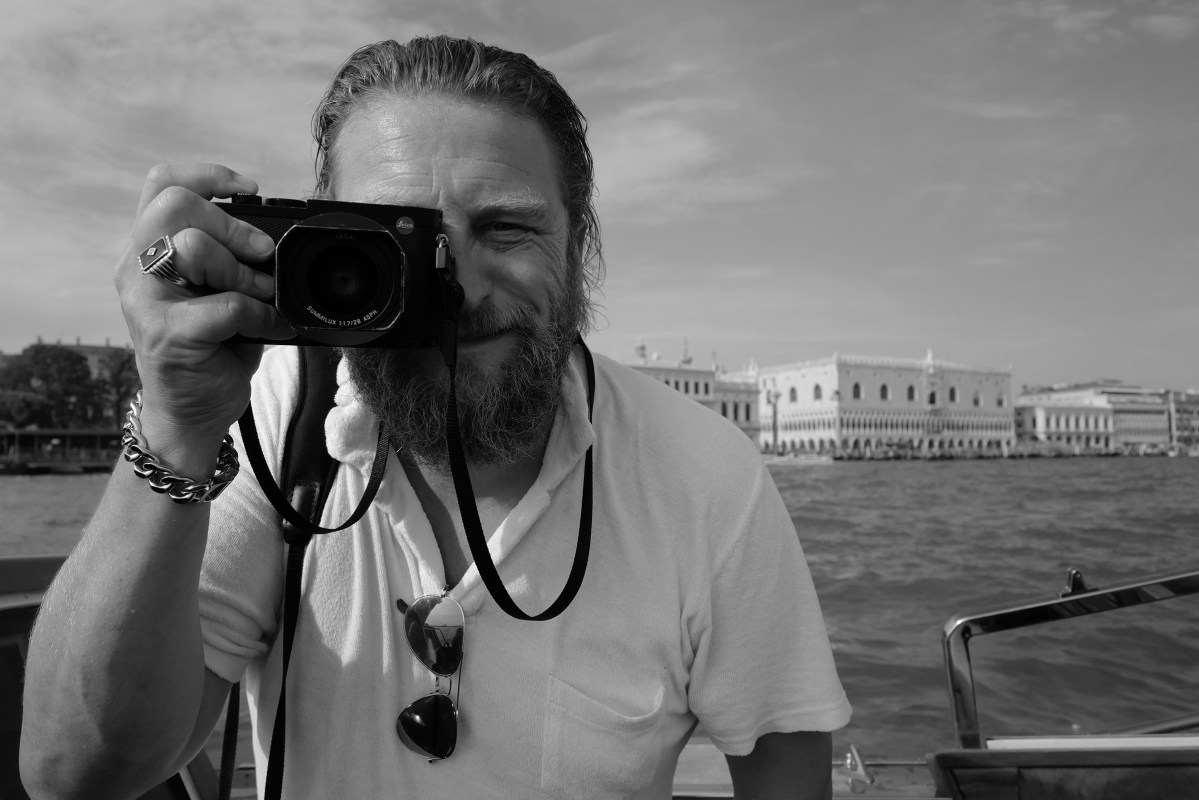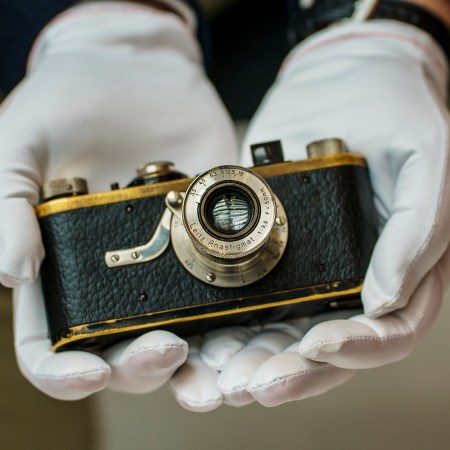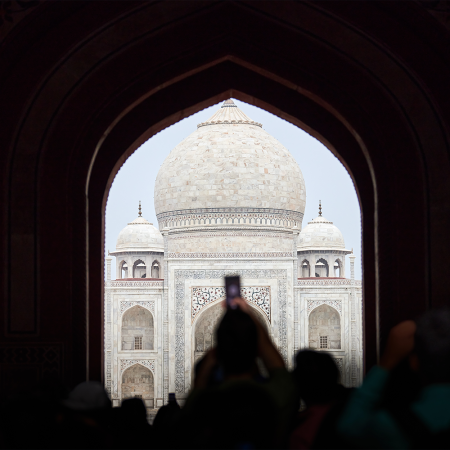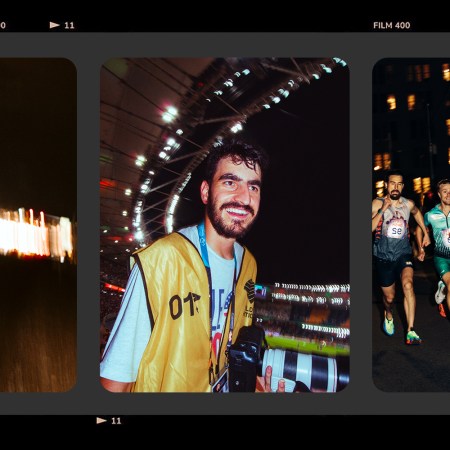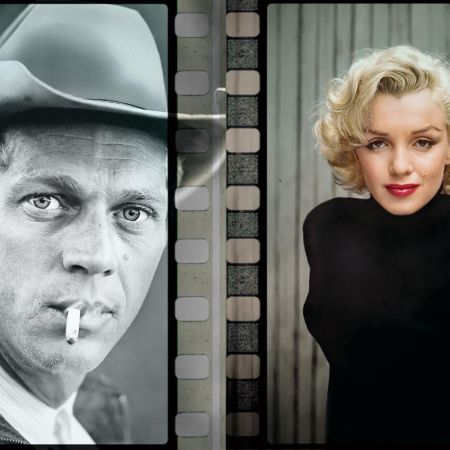There are many celebrity photographers out there, but nobody hits the casual-highbrow button quite like Greg Williams.
The British photographer started out as a war photographer in the 1990s, having shot everywhere from Burma to Sierra Leone. But things took a turn toward Hollywood when the Sunday Times Magazine offered Williams a red-carpet assignment, and he has since shot on set for more than 200 films, including poster campaigns for the Bond franchise (he even has his own limited-edition Leica Q2 camera, which was created in partnership with James Bond actor Daniel Craig).
He has since gained exclusive access to the Golden Globes and the Oscars and is known for his high-spirited, energetic photos of stars at events, whether it’s high-fiving stars as he shoots them, backstage access at the Venice Film Festival or shooting stars in their Cannes hotel rooms. Over the past 23 years, he has traveled to film festivals and awards shows across the globe, shooting everyone from Beyoncé to Lady Gaga to Lionel Messi, all of whom have entrusted their image to his at once exacting and whimsical gaze.
Recently, he partnered with beverage brand Martini & Rossi to help aspiring photographers get their best shots. The campaign allows budding photographers to submit group photos with the hashtag #MartiniMoments, and four winners will be selected to be shot with their friends by Williams himself.
We recently chatted with Williams from his studio in London’s Mayfair district about his most iconic photos, why he loves Old Hollywood and texting Dakota Johnson.
InsideHook: You recently returned from the Venice Film Festival, what made it different this time around?
Greg Williams: It felt like we were almost getting back to normal, which feels like a scary thing to say. I’ve been to the Venice Film Festival for seven years now. Last year was extraordinary because it was so difficult — it could have failed but it didn’t. They pulled it off. It was so limited. There were almost no Americans there. This year, the big American films are back. It feels like we’re back at a proper film fest. Venice is my favorite film festival by a long shot — it’s so photogenic. It’s Venice. The boats make such a difference. You can get into boats like you normally get into cars. The private boats seat 12 people, so there’s a place to work. For me, I’m caught up in this nostalgic image of Hollywood. I can still create those images today, that’s why I love Venice. It was optimistic this year.
On that note of old Hollywood, how do you shoot stars today — whether it’s full-on, produced shoots or off-the-cuff shots of celebs at parties — with a sense of historic charm?
When I look back on my favorite photos from the old LIFE magazines of the 1950s and 1960s, there was quite a lot of interaction between stars and photographers. It disappeared in the 1980s, due to a mixture of paparazzi becoming a bigger deal and publicists controlling talent. There was this movie-star-put-on-a-pedestal photograph as a God-like figure that Herb Ritts would do so beautifully. Then you would have paparazzi photographers selling exclusives of people doing things wrong for hundreds of thousands to the tabloids.
What was it like when you got into celebrity photography at the time?
When I started my work in the 1990s, which was a candid sort of reportage of the stars, it was inspired by the work created from the 1940s to the 1970s. But it didn’t exist anymore. It’s back for a number of reasons. Things have changed with social media, but also, many publications don’t have budgets anymore. The aggression of the paparazzi has softened — I wouldn’t say it has gone away, but it has softened, because you’re not chasing a hundred-grand exclusive, you’re chasing not a lot of money for the Mail Online. It’s a very different thing.
What do you think makes you stand out compared to other celebrity photographers?
What has happened perfectly for me, not that it was planned, was that people love good photos of themselves. There’s something in the way I shoot; even though I use modern cameras, my pictures sing of yesteryear. But they still have a modern appeal to them. I’ve spent the past number of years working on relationships and trust. I like to think I’ve never screwed anyone over. Over the past 23 years photographing in the industry, I have the trust of almost everyone I photograph now.
One of the people you photograph over and over again is Cate Blanchett. How has your relationship developed over the years?
I met Cate on the set of the film Elizabeth in 1997, which was I think the first movie set I was ever on. That was her first big movie she was the star of. I’ve been on set with Cate at least five times. A few years ago, we shot photos at the Cannes Film Festival. We work really well together, we’re both really collaborative. I don’t believe you should walk into a room with someone that talented and tell them what the picture is. I think you can find the picture together. Some of my favorite photos of Cate were collaborations or her idea. There’s a wonderful shot of her with her toddler dancing between her legs, that was entirely Cate’s idea. She knew she could come to me with it, and we’d get it. It was spontaneous; it was an idea she had 20 seconds before we took the picture. I had left the room by that point and heard someone call back: “Come back! Come back! Look at this!” That’s where the photo came from. We always pull something off.
You’ve also shot Dakota Johnson frequently, what has that been like?
I have shot Dakota Johnson a lot, but never ever in any official capacity. Every time we’ve shot, it has been casual. We met at a party at the Venice Film Festival in 2016. I showed her some of my work and asked if we could take some photos. She said, “Sure.” We just went for a walk and we took photos under the street lights. We exchanged numbers. Whenever I was in Los Angeles or in Cannes or whatever, I would text her and say, “Can we take some pictures?” And she’d say, “Yeah.” I’d just turn up. One time, we ran into each other at the Chateau Marmont. We went for a drive, got a coffee and played some records at her house. It has never been a commission.
It sounds like your photos are a byproduct of your friendship with these stars, who else do you have this connection with?
Quite a lot of people, and on different levels. People I shoot regularly include Tom Hardy — I’ve known him since he was 15, before he was acting. We go way back. I’ve shot Daniel Craig, Kate Winslet and Russell Crowe many times, as well as Joaquin Phoenix and Rami Malek, who I’ve shot a great deal.
You photographed Lady Gaga right after her Oscar win, an emotional photo where she’s crying. What was it like being backstage for that moment?
I have shot her on a couple of occasions, but I didn’t particularly know her. I just shot what I saw. It was an honest emotional reaction to something that was clearly an incredibly important moment in her life. I was one of the official photographers at the Oscars that year. She literally just came offstage, and I took that picture
What can you tell us about the Martini & Rossi campaign that you’re doing?
We’ve put together a photography competition and the idea is to celebrate friends reconnecting after this year and a half of not seeing each other. We’re looking to create imagery that sums up this unique time in history where people are coming back together after so long. I did a shoot with my wife and some of my mates. I’ve shared photography tips on how to make pictures better. Part of the reason why it came together is because I did this photo course called Skills Faster, which is very much about democratizing good photography. It’s not about the camera you use, but thinking like a photographer about light, narrative and composition. There’s a lot of people who say, “I can’t take a good picture.” My response to them is, “You just haven’t thought about it. If you just raise your camera to take a shot, that tells me you haven’t thought about the photo you’re taking.” I want people to take better photos from a legacy standpoint, but also from a business standpoint. There’s something cool in helping people do something better.
This article appeared in an InsideHook newsletter. Sign up for free to get more on travel, wellness, style, drinking, and culture.
